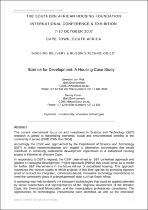JavaScript is disabled for your browser. Some features of this site may not work without it.
- ResearchSpace
- →
- Research Publications/Outputs
- →
- Conference Publications
- →
- View Item
| dc.contributor.author |
Van Wyk, Llewellyn V

|
|
| dc.contributor.author |
Kistan, Kenny F

|
|
| dc.date.accessioned | 2007-11-08T07:58:25Z | |
| dc.date.available | 2007-11-08T07:58:25Z | |
| dc.date.issued | 2007-10 | |
| dc.identifier.citation | Van Wyk, L and Kistan, K. 2007. Science for development: a housing case study. The Southern African Housing Foundation International Conference and exhibition, Cape Town, South Africa, 7-10 October, 2007, pp 10 | en |
| dc.identifier.uri | http://hdl.handle.net/10204/1456 | |
| dc.description | 2007: The Southern African Housing Foundation International Conference and exhibition | en |
| dc.description.abstract | The CSIR was approached by the Department of Science and Technology (DST) to make recommendations with regard to alternative technologies that would contribute to achieving sustainable development imperatives in a subsidised housing project in Kleinmond, Western Cape. In responding to DST’s request, the CSIR determined an S&T contextual approach and applied a Packaged Development Project Approach (PDPA) that could serve as a model for further S&T interventions in the future roll-out of subsidised housing. This approach maximizes the various scales at which projects of this kind operate by providing rigorous proof of concept for integrated, community-based, innovative technology interventions to meet the community goals of a developmental state such as South Africa. The identified technologies for municipal services include re-designing the roads; re-using local soils rather than importing soils for the road bases and sub-bases; rainwater harvesting; sustainable urban drainage systems; waste and soil water treatment; and energy generation and saving. No technologies were identified for the township layout although recommendations were made about orientation in certain cases. The identified technologies for housing construction included a concrete framed structure rather than a masonry plinth; lightweight infill panels; and exploiting the repetitiveness of the units and the scale of the project to prefabricate as many of the construction components as possible, in line with the current concept of Modern Methods of Construction (MMC). | en |
| dc.language.iso | en | en |
| dc.subject | Sustainability | en |
| dc.subject | Innovative technologies | en |
| dc.subject | PDPA | en |
| dc.subject | Packaged development project approach | en |
| dc.title | Science for development: a housing case study | en |
| dc.type | Conference Presentation | en |
| dc.identifier.apacitation | Van Wyk, L. V., & Kistan, K. F. (2007). Science for development: a housing case study. http://hdl.handle.net/10204/1456 | en_ZA |
| dc.identifier.chicagocitation | Van Wyk, Llewellyn V, and Kenny F Kistan. "Science for development: a housing case study." (2007): http://hdl.handle.net/10204/1456 | en_ZA |
| dc.identifier.vancouvercitation | Van Wyk LV, Kistan KF, Science for development: a housing case study; 2007. http://hdl.handle.net/10204/1456 . | en_ZA |
| dc.identifier.ris | TY - Conference Presentation AU - Van Wyk, Llewellyn V AU - Kistan, Kenny F AB - The CSIR was approached by the Department of Science and Technology (DST) to make recommendations with regard to alternative technologies that would contribute to achieving sustainable development imperatives in a subsidised housing project in Kleinmond, Western Cape. In responding to DST’s request, the CSIR determined an S&T contextual approach and applied a Packaged Development Project Approach (PDPA) that could serve as a model for further S&T interventions in the future roll-out of subsidised housing. This approach maximizes the various scales at which projects of this kind operate by providing rigorous proof of concept for integrated, community-based, innovative technology interventions to meet the community goals of a developmental state such as South Africa. The identified technologies for municipal services include re-designing the roads; re-using local soils rather than importing soils for the road bases and sub-bases; rainwater harvesting; sustainable urban drainage systems; waste and soil water treatment; and energy generation and saving. No technologies were identified for the township layout although recommendations were made about orientation in certain cases. The identified technologies for housing construction included a concrete framed structure rather than a masonry plinth; lightweight infill panels; and exploiting the repetitiveness of the units and the scale of the project to prefabricate as many of the construction components as possible, in line with the current concept of Modern Methods of Construction (MMC). DA - 2007-10 DB - ResearchSpace DP - CSIR KW - Sustainability KW - Innovative technologies KW - PDPA KW - Packaged development project approach LK - https://researchspace.csir.co.za PY - 2007 T1 - Science for development: a housing case study TI - Science for development: a housing case study UR - http://hdl.handle.net/10204/1456 ER - | en_ZA |






